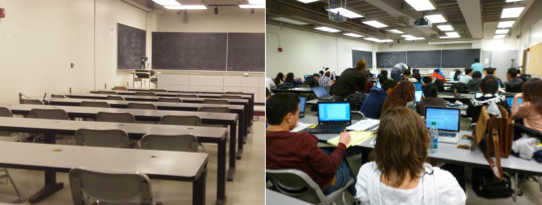by Olivia Wrigley
Human occupants and their belongings found to be the primary contributors to volatile organic compounds in a lecture theatre
US researchers found that people and their possessions directly emitted 57% of the volatile organic compounds (VOCs) they measured in the air of a university lecture theatre[1]. We spend approximately 90% of our life inside, where concentrations of VOCs are consistently found to be much higher than in outdoor air[2]. This research is one of the first few to detail the important role that emissions from direct human occupancy plays here.

VOCs have been linked to sick building syndrome and can react in the air to from secondary pollutants, including those harmful to health such as the carcinogen formaldehyde[3].
The research team, consisting of two postdoc researchers Xiochen Tang and Pawel Miszal and lead by Allen Goldstein and William Nazaroff at the University of California at Berkeley continuously sampled the air entering and leaving a lecture theatre in the university’s engineering department for a fortnight. The team isolated 400 VOCs in the air and determined three possible sources for their contributions: air coming in from outside, furnishings in the room, and the human occupants and their belongings. Around 220 of these compounds were found to be more abundant in the occupied lecture theatre than in the air coming in from outside, or in the empty room, confirming that, by weight, human occupants were the source of 57% of the indoor VOCs whenever at least 20 students were in the lecture theatre.
The most dominant VOCs measured in the occupied lecture theatre were cyclic volatile methylsiloxanes – a result that Goldstein says “shocked and maybe even horrified” him. Methylsiloxanes are man-made chemicals found in many personal care products, particularity antiperspirants, and were found in a much higher concentration in the occupied lecture theatre than are typically measured outdoors. Interestingly, methylsiloxanes abundance was consistently much higher for the first morning classes than in classes later in the day. Demonstrating how emissions from personal care products decrease with time after application.
Individually, we can reduce the personal care and cleaning products we wear and use around our homes. Goldstein, however, remarks that our “exposures in crowded spaces are dominated by choices other people are making”.
Data collected also allowed the team to calculate average emission rates per person for each compound, a complete set of which, Goldstein explained, is novel. Although, Goldstein admits that an engineering student might not represent the average human! These emission rates are very useful as inputs for indoor air pollution models.
[1] Tang, X., Misztal, P. K., Nazaroff, W. W. and Goldstein, A. H. Volatile Organic Compound Emissions from Humans Indoors. Environment, Science & Technology. 2016;50:12686-12694.
[2] McDonald, B. C., de Gouw, J. A., Gilman, et al. Volatile chemical products emerging as largest petrochemical source of urban organic emissions. Atmospheric Chemistry. 2018;359:760-764.
[3] Wolkoff, P. Volatile organic compounds – Sources, measurements, emissions and the impact on indoor air quality. Indoor Air. 1995;5(Suppl. 3):11-41.